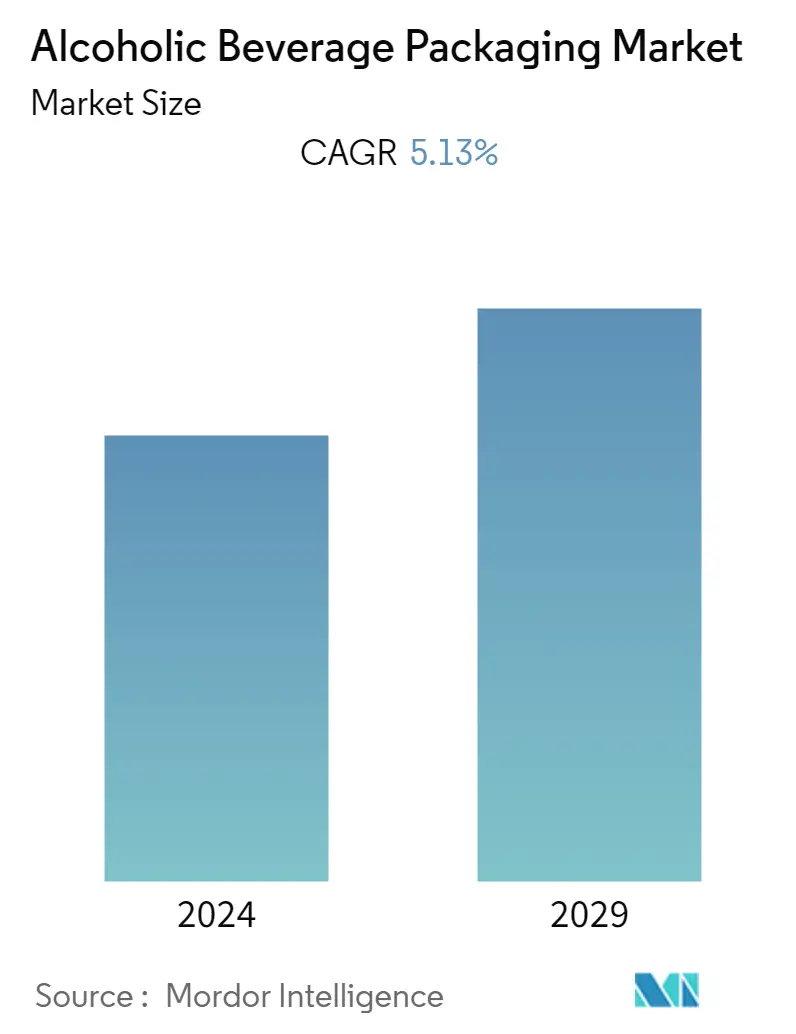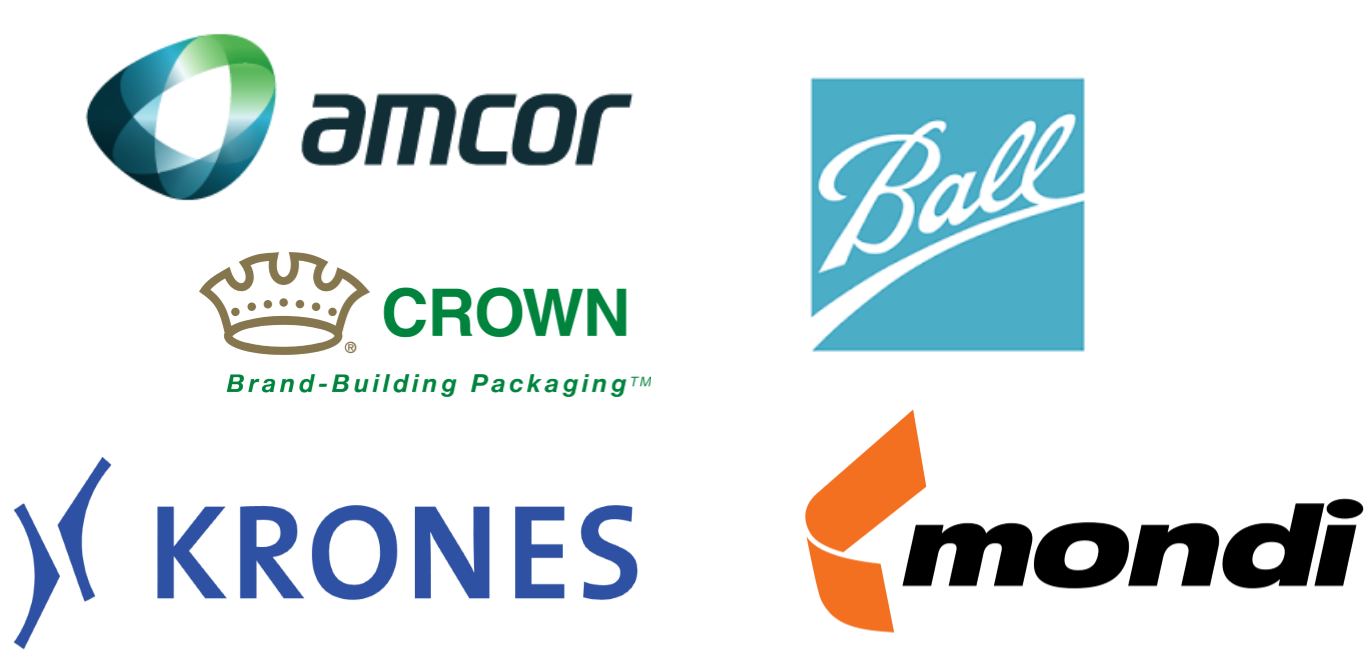Market Size of Alcoholic Beverage Packaging Industry

| Study Period | 2019 - 2029 |
| Base Year For Estimation | 2023 |
| CAGR | 5.13 % |
| Fastest Growing Market | Asia Pacific |
| Largest Market | Asia Pacific |
| Market Concentration | Low |
Major Players
*Disclaimer: Major Players sorted in no particular order |
Alcoholic Beverage Packaging Market Analysis
The alcoholic beverage packaging market was valued at USD 63.43 billion in 2020 and is expected to reach USD 93.68 billion by 2026, at a CAGR of 5.13% over the forecast period 2021 - 2026. The packaging of alcoholic beverages plays a significant role in the brand promotion of alcohol. The alcoholic beverage industry highlights the innovations, including enhanced branding and unconventional packaging formats, such as paper wine bottles, whiskey pouches, etc.
- It was observed that the global consumption of alcoholic beverages has been increasing significantly, over the decades. According to the study conducted by Lancet, alcohol per-capita consumption increased from 59 liters in 1990 to 65 liters in 2017, globally. Furthermore, in the following 13 years, alcohol per-capita consumption is expected to grow by 17%, reaching 76 liters in 2030. The rising alcoholic beverage consumption is one of the key factors driving market growth.
- Additionally, owing to the awareness regarding the usage of 100% recyclable products, in order to minimize packaging waste, the focus on recycling packagings is growing. This is, thus, fuelling the demand for sustainable packaging products and supporting the growth of the alcoholic beverage packaging market.
- However, stringent government regulations on the use of hazardous and non-biodegradable products have limited the manufacturers to a few packaging materials. Furthermore, the increasing cost of production is also restricting the growth of the market studied.
Alcoholic Beverage Packaging Industry Segmentation
The scope of the alcoholic beverage packaging market study is limited to the packagings offered by the various vendors, made of different packaging materials. The trend of using non-conventional packaging for alcoholic beverages is increasing. Thus, the study also considers the global usage of different products, like paper wraps and plastic bags.
| By Material | |
| Glass | |
| Metal | |
| Plastic | |
| Other Materials |
| By Product | |
| Cans | |
| Bottles | |
| Other Products |
| Geography | ||||||
| ||||||
| ||||||
| ||||||
|
Alcoholic Beverage Packaging Market Size Summary
The alcoholic beverage packaging market is experiencing significant growth, driven by the increasing global consumption of alcoholic beverages and the demand for innovative packaging solutions. The industry is witnessing a shift towards sustainable and recyclable packaging materials, such as glass, which is favored for its quality and recyclability. This trend is further supported by the rising awareness of environmental issues and the need to minimize packaging waste. The market is characterized by a variety of packaging formats, including paper wine bottles and whiskey pouches, which are gaining popularity for their unique branding opportunities. However, the market faces challenges due to stringent government regulations on hazardous materials and the rising costs of production, which limit the options available to manufacturers.
The demand for glass packaging, particularly in the wine and beer segments, is expected to grow, supported by the robust consumption of these beverages globally. The wine industry, in particular, is projected to see significant growth, with glass containers dominating the packaging application due to their recyclability and quality. In regions like Southeast Asia and the West Pacific, the increasing consumption of spirits and beer, coupled with a large consumer base and rising disposable incomes, is driving market expansion. The competitive landscape is moderately fragmented, with numerous players offering packaging solutions and implementing strategies to enhance their market presence. Notable industry movements include Diageo's commitment to eliminating plastic packaging and Amcor's acquisition of Bemis Company, highlighting the focus on sustainable and innovative packaging solutions.
Alcoholic Beverage Packaging Market Size - Table of Contents
-
1. MARKET DYNAMICS
-
1.1 Market Overview
-
1.2 Market Drivers
-
1.2.1 Increasing Consumption of Alcoholic Beverages
-
1.2.2 Increased Focus on Recycling
-
1.2.3 Rising Demand for Long Shelf Life of the Product
-
-
1.3 Market Restraints
-
1.3.1 Implementation of Stringent Regulations on Packaging Materials
-
-
1.4 Industry Value Chain Analysis
-
1.5 Industry Attractiveness - Porter's Five Forces Analysis
-
1.5.1 Threat of New Entrants
-
1.5.2 Bargaining Power of Buyers/Consumers
-
1.5.3 Bargaining Power of Suppliers
-
1.5.4 Threat of Substitute Products
-
1.5.5 Intensity of Competitive Rivalry
-
-
-
2. MARKET SEGMENTATION
-
2.1 By Material
-
2.1.1 Glass
-
2.1.2 Metal
-
2.1.3 Plastic
-
2.1.4 Other Materials
-
-
2.2 By Product
-
2.2.1 Cans
-
2.2.2 Bottles
-
2.2.3 Other Products
-
-
2.3 Geography
-
2.3.1 North America
-
2.3.1.1 Unites States
-
2.3.1.2 Canada
-
-
2.3.2 Europe
-
2.3.2.1 Germany
-
2.3.2.2 United Kingdom
-
2.3.2.3 France
-
2.3.2.4 Rest of Europe
-
-
2.3.3 Asia-Pacific
-
2.3.3.1 China
-
2.3.3.2 Japan
-
2.3.3.3 India
-
2.3.3.4 Rest of Asia-Pacific
-
-
2.3.4 Rest of the World
-
2.3.4.1 Latin America
-
2.3.4.2 Middle East & Africa
-
-
-
Alcoholic Beverage Packaging Market Size FAQs
What is the current Alcoholic Beverage Packaging Market size?
The Alcoholic Beverage Packaging Market is projected to register a CAGR of 5.13% during the forecast period (2024-2029)
Who are the key players in Alcoholic Beverage Packaging Market?
Amcor PLC, Ball Corporation, Krones AG, Mondi PLC and Crown Holdings Inc. are the major companies operating in the Alcoholic Beverage Packaging Market.

